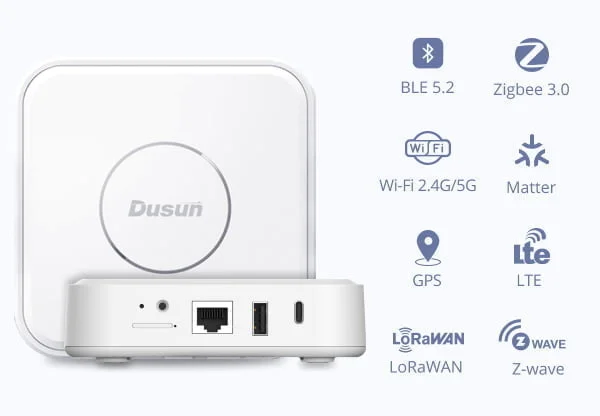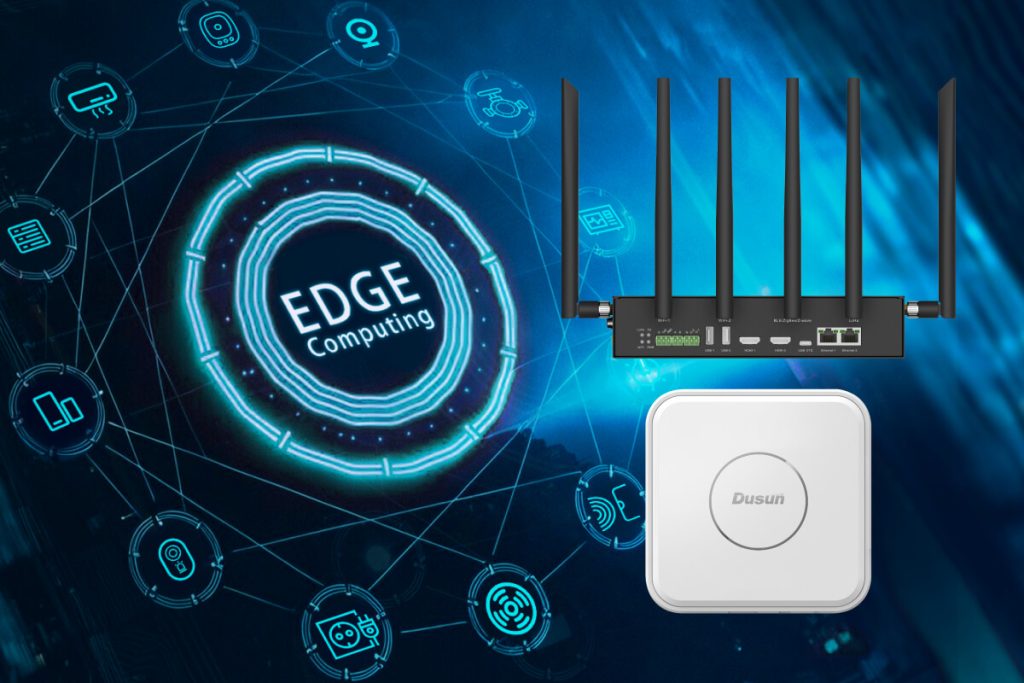Edge computing is a distributed information technology architecture that brings data processing and storage near the data source and where data is consumed. This model is important for organizations and businesses because it enables them to handle large amounts of data locally.
The result is lower latency, faster applications, real-time analysis, improvement in overall efficiency, and optimization of day-to-day operations.
Let’s look at the devices that enable edge computing in detail, including their types, roles, and use cases.
What Is an Edge Computing Device?
An edge computing device is a piece of hardware that enables data processing and storage near the source and consumption point. Therefore, this component must have some computing power in the form of a microcontroller, SoC, or microprocessor. It should also have memory (volatile and non-volatile).
These devices fall into these four broad categories.
- Device edge
- Compute edge (micro data centers)
- Cloud edge (large data centers)
- Sensor edge
We can expound the devices in these categories into the following types.
Types of Edge Computing Devices
IoT Gateways
Edge Computing gateways are the primary edge computing devices because they run the edge networks. They are equivalent to routers in wireless (Wi-Fi) and wired local area networks but are specialized to provide connectivity, security, and management of the end nodes. Also, they process and store data locally while communicating with the cloud to access more powerful computing power and larger storage for analytics.
For instance, the DSGW-210 Edge Computing Gateway enables smarter and more efficient management of IoT devices in smart homes, retail, and buildings. Additionally, it integrates with AWS IoT Greengrass to enable more responsive IoT applications that run more reliably even with intermittent cloud connections.

The DSGW-380 Industrial Edge Computing Gateway is even more powerful because it features a heterogeneous multicore SoCs (RK3588) with NPUs and GPUs to run powerful analytics, automation, and prediction/forecasting applications.
Servers
The computing and cloud edge categories require servers to provide the required processing power. Servers are powerful computers, and they provide more computational power than IoT gateways.
These devices are more common in the central cloud. But they can also run some functions on the edge. For instance, the cloud edge keeps the data centers close to the users or end devices. This setup significantly reduces latency, making applications run fast and smoothly.
However, servers are expensive, so they are best suited for enterprises and large organizations. Additionally, their high processing power makes them ideal for running AI models (machine learning) to enhance business operations.
For the computing edge, small, purpose-built computers or servers can be assembled to form micro data center stacks on the edge. These servers are more modular, scalable, and adaptable than those in traditional data centers, and have a smaller footprint.
Micro data centers are ideal for organizations that lack central data centers nearby and need to process more data than gateways can handle.
Sensors
Sensors are the data sources in the IoT network. They collect various environmental data like pressure, temperature, humidity, water quality, and motion variables.
Traditional sensors don’t provide edge computing. However, some use cases, such as industrial equipment and processes, benefit greatly from having edge computing on the sensor. For instance, sensors monitoring machines in a factory can process some of the critical performance data locally and initiate a shutdown if they detect an anomaly (erroneous data).
Smart Cameras
Conventional cameras only capture images and store the data. They don’t qualify as edge computing devices because they do not process image data. Instead, you have to transfer the images to a computer or cloud for processing before final use.
But smart cameras introduce data processing into the mix, providing AI image editing, pattern recognition, and other machine learning technologies that:
- Track objects
- Decipher text and colors
- Monitor scene changes
This local processing reduces the need to send all the captured images to the cloud, which cuts bandwidth costs and enables real-time analysis.
Practical smart camera applications include security systems or CCTV cameras on the streets, which can run AI algorithms locally to analyze the raw footage and look for certain human behavior or traffic patterns. In stores, smart cameras can help optimize product placement on the shelves or the store’s layout.
The DSOM-040R system on module based on Rockchip RK3588 processor not only supports up to 6TOPS AI computing power, but also has powerful multimedia processing functions and rich interface scalability. Its efficient AI processing capabilities and low power consumption design can provide reliable hardware support for high-computing AI cameras.
Processors
Processors are the integrated circuits that provide the required processing power to run edge computing devices. IoT gateways usually run on SoCs, which are not as powerful as microprocessors but are catching up. Their primary advantage is low power consumption.
But in the processor or MPU category, the available options are CPUs, GPUs, or specialized processors. You can use these chips individually or combined in a multicore IC to run multiple computation functions on the edge
You may interested in: MCU vs. SoC vs. MPU For IoT Devices: Factors To Consider When Selecting The Brains For IoT Devices
Central Processing Unit
These general-purpose processors usually have 4 to 16 cores, which enable them to perform complex functions at high speeds. However, they consume more power than SoCs, making them suitable for servers, not IoT gateways.
Graphics Processing Unit
GPUs are specialized processors that support the CPU in handling graphics processing tasks. Compared to CPUs, GPUs process tasks faster because they break them down into smaller computations, and process them in parallel. Most companies use GPUs for AI inferencing due to their quick parallel processing capabilities. But this fast computing comes at a cost: high power consumption.
Specialized Customizable Processors
Customizable processors like ASICs and FPGAs provide high computing performance while consuming relatively low power.
uCPE
Universal customer premises equipment are computing boxes that replace multiple edge networking hardware and service providers, such as routers and firewalls, with software. This software is in the form of Virtual Network Functions.
Since they can have additional unused space and processing power, they can run enterprise applications.
The Role of Edge Computing Devices
Enables Low-Latency, Real-Time Processing
Latency comes about when data has to travel long distances from the source to the processing unit, and then to the consumption point. By performing processing and storage near the edge, latency is kept to the minimum or even eliminated, enabling real-time data analysis.
Additionally, even if the cloud connection goes off, the edge network and devices will continue working because there is a brain and memory in the system.
For instance, autonomous vehicles can be able to process data from their sensors locally, enabling quick real-time decision-making without relying on the cloud.
Enables Autonomy
Real-time processing with low latency enables machines and vehicles to run autonomously because they can make independent decisions on the fly. Adding AI to the mix, which is now possible on the edge, increases the level of autonomy these machines can provide to users.
Making Business Operations and Data Analytics More Efficient
Processing data on the edge makes business operations run more efficiently, simplifies data analytics, and improves employee productivity. These factors give organizations a competitive advantage in the market.
Enhances Data Security
Data breaches often occur when data crosses over from the local network to the wide area network when the edge device communicates with the cloud. By storing and processing data locally, the information transmitted to the cloud is minimized, meaning more data will be safe. Even if there is a breach on the outside network, the attackers won’t get access to critical data processed and stored on the edge.
Improves Workplace Safety
IoT sensors and other edge computing devices can detect and determine if there is a safety issue in risky workplaces like oil rigs and fuel pipelines, then shut off the systems automatically before disaster strikes.
Delivers Personalized Services to the Specific Network
Instead of relying on a central cloud to serve remote sites using the same hardware, edge computing devices provide each site with the specific hardware to run personalized services.
For instance, an organization can install servers with NPUs on the location specialized to handle predictive or forecasting tasks using AI (neural networks). The retail and wholesale section can have edge computing gateways with positioning engines, while the sales analysis department can have a localized network running on CPU servers.
Reduces IT Costs
Edge computing reduces reliance on the cloud, which means organizations pay less for cloud processing and storage. It also minimizes the bandwidth required for data transmission to the cloud, hence lower internet costs.
Edge Computing Device Use Cases
- Smart Homes: One example is a smart home assistant, which responds faster if it processes the data locally. Others include automated AC temperature control using the gateway, security cameras, smart lighting, intelligent appliances, and smart door locks.
- Smart Buildings: Edge computing devices help with intrusion detection, access control, occupancy management, automated AC adjustment, and asset tracking.
- Autonomous Vehicles: Its possible to eliminate drivers in personal cars and cabs using powerful edge computing, or even have only one driver in the front of a truck convoy. The rest will follow the leader autonomously while communicating with each other to maintain distance and speed.
- Smart Retail: Edge computing optimizes stock tracking, surveillance, sales tracking, proximity marketing, inventory management, and consistent offerings in retail environments.
- Manufacturing and Warehousing: Edge devices enable real-time asset tracking, employee tracking, remote asset monitoring (oil and gas production), temperature monitoring, and predictive maintenance.
- Smart Farming: The primary application areas include automated temperature control/adjustment in greenhouses, soil monitoring, automated irrigation, and livestock management (tracking, automated feeding, and health monitoring).
- Smart Healthcare: Maintain patient data privacy by processing data locally and monitoring patients remotely.
- Online Gaming and Video Streaming: Moving servers/data centers closer to the edge (players and viewers) to reduce latency and deliver a more immersive experience.
- Smart Cities: Monitoring public transport to open and close extra lanes, managing street lighting, and traffic management, especially as autonomous cars increase on the roads.
- Smart Grids: To monitor energy use and analyze consumption.
Final Thoughts
Edge computing devices have transformed home, business, automotive, and city environments by introducing autonomy, real-time analysis, and data safety. Granted, the technology has its downsides, such as limited processing capabilities on some devices, but the benefits far outweigh these issues.
Therefore, this hardware is especially critical for customers who want to have a competitive edge in the market, and we can help you provide these solutions affordably with a quick turnaround time.
Our focus is on IoT Edge computing gateways and end nodes, which are vertically integrated to ensure smooth interconnectivity and interoperability. We can manufacture these devices from scratch if you have custom designs or you can opt for ready-made units to reduce the time to market. Either way, contact us with your details, and we’ll discuss the best way forward.




















 Is there anything we can help you with today?
Please fill in the form below for the team to follow up if you become disconnected.
Is there anything we can help you with today?
Please fill in the form below for the team to follow up if you become disconnected.